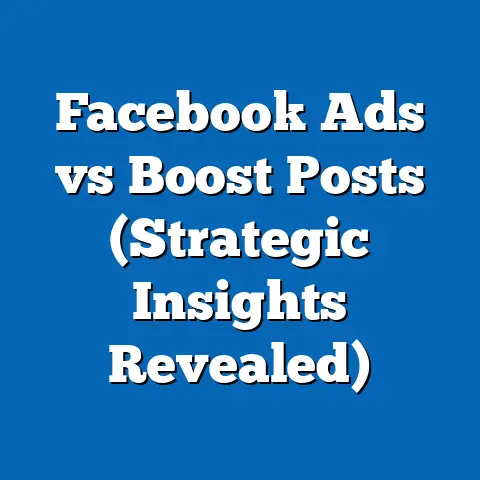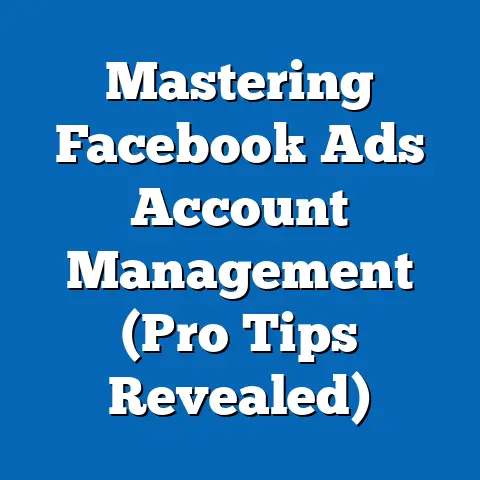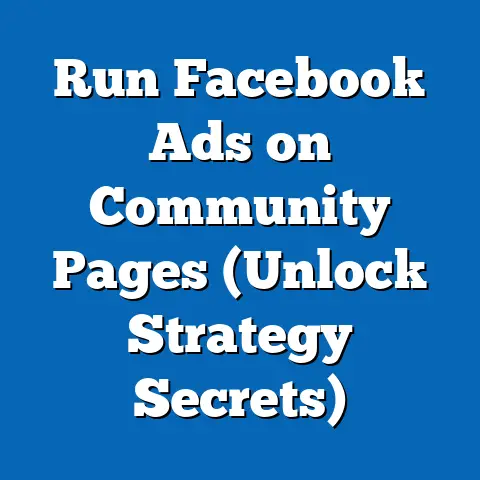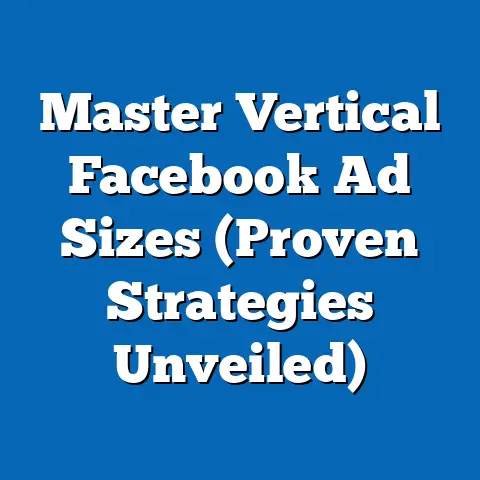Revolutionize Campaigns with Facebook Ads API (Game-Changer)
What if you could wave a magic wand and suddenly have the power to hyper-personalize your Facebook ad campaigns, automate tedious tasks, and analyze performance data with laser-like precision? Sounds like a dream, right? Well, it’s not magic; it’s the Facebook Ads API, and it’s a game-changer for marketers who are serious about getting the most out of their ad spend. I remember when I first started in digital marketing, I was drowning in spreadsheets and manual adjustments. The idea of automating even a small part of that process felt like winning the lottery. Now, with the Facebook Ads API, that level of automation and control is within reach for businesses of all sizes.
Understanding Facebook Ads API
The Facebook Ads API (Application Programming Interface) is essentially a set of tools and protocols that allows developers and marketers to interact with the Facebook advertising platform programmatically. Think of it as a secret back door that lets you bypass the standard Facebook Ads Manager interface. Instead of clicking buttons and filling out forms, you can write code to create, manage, and analyze your ad campaigns.
Its primary purpose is to streamline and automate advertising processes, enabling businesses to scale their campaigns more efficiently. Instead of manually updating bids or pausing underperforming ads, you can use the API to set up rules and algorithms that handle these tasks automatically. This frees up your time to focus on strategy and creative development – the things that truly make a difference.
The integration with businesses’ advertising strategies is profound. It allows for deeper customization, real-time optimization, and the ability to connect Facebook Ads data with other marketing platforms. For example, you could integrate your CRM data to create highly targeted custom audiences or use the API to automatically generate ad creatives based on product inventory.
The growth and impact of Facebook advertising are undeniable. According to Statista, Facebook’s advertising revenue continues to climb, demonstrating its importance in the digital marketing landscape. With billions of users, Facebook remains a crucial platform for reaching a wide audience, and the Ads API is the key to unlocking its full potential.
Takeaway: The Facebook Ads API is a powerful tool that allows for programmatic interaction with the Facebook advertising platform, enabling automation, customization, and scalability in your campaigns.
The Need for Automation in Advertising
In the old days (which, in digital marketing terms, means about five years ago!), advertising was a much more manual process. Marketers spent hours poring over reports, tweaking bids, and creating ad variations. It was time-consuming, prone to human error, and often resulted in missed opportunities.
The challenges faced by marketers in traditional advertising methods are significant. These include:
- Time Constraints: Manually managing campaigns takes up valuable time that could be spent on strategy and creative development.
- Scalability Issues: Scaling campaigns manually is difficult and often requires hiring additional staff.
- Lack of Real-Time Optimization: Manual adjustments are reactive, meaning you’re always playing catch-up to changes in performance.
- Limited Customization: The standard Ads Manager interface offers limited customization options, making it difficult to create truly unique and personalized experiences.
The advantages of automation are clear:
- Efficiency: Automate repetitive tasks, freeing up time for strategic thinking.
- Scalability: Easily scale campaigns without adding more manual labor.
- Data-Driven Decision-Making: Make informed decisions based on real-time data and insights.
- Personalization: Create highly customized ad experiences for different audience segments.
I remember working with a small e-commerce business that was struggling to manage their Facebook ad campaigns manually. They were spending hours each week updating bids and pausing underperforming ads, but they weren’t seeing the results they wanted. After implementing a simple API-based solution to automate their bidding strategy, they saw a 30% increase in conversions and a significant reduction in their cost per acquisition.
Takeaway: Automation is essential for modern advertising, offering efficiency, scalability, data-driven decision-making, and personalization that traditional methods simply can’t match.
Key Features of the Facebook Ads API
The Facebook Ads API is packed with features that can transform the way you manage your campaigns. Let’s break down some of the core functionalities:
- Campaign Management: This allows you to create, update, and manage your ad campaigns programmatically. You can define your campaign objectives, set budgets, and schedule your ads all through code. This is particularly useful for managing large campaigns with complex structures.
- Audience Targeting: The API provides access to Facebook’s powerful targeting capabilities, allowing you to create highly specific audiences based on demographics, interests, behaviors, and custom data. You can also use the API to create lookalike audiences based on your existing customer data.
- Dynamic Ads: Dynamic ads are a game-changer for e-commerce businesses. The API allows you to automatically generate ads based on your product catalog, showing users the products they’re most likely to be interested in. This is incredibly effective for retargeting and driving sales.
- Performance Analytics: The API provides access to a wealth of performance data, allowing you to track key metrics like impressions, clicks, conversions, and cost per acquisition. You can use this data to identify trends, optimize your campaigns, and make data-driven decisions.
Each of these features offers practical benefits for advertisers. For example, with campaign management, you can automate the process of launching new campaigns or updating existing ones. With audience targeting, you can create highly specific audiences that are more likely to convert. And with performance analytics, you can gain valuable insights into what’s working and what’s not, allowing you to continuously improve your campaigns.
Takeaway: The Facebook Ads API offers a range of powerful features, including campaign management, audience targeting, dynamic ads, and performance analytics, all designed to help you optimize your advertising efforts.
How to Get Started with Facebook Ads API
Getting started with the Facebook Ads API might seem daunting at first, but it’s actually quite straightforward once you understand the basic steps. Here’s a step-by-step guide:
- Obtain a Developer Account: You’ll need a Facebook Developer account to access the API. You can create one by visiting the Facebook Developers website and following the instructions.
- Create an App: Once you have a developer account, you’ll need to create an app. This app will be used to authenticate your API requests and manage your advertising data.
- Understand the Necessary Endpoints: The API is organized into endpoints, which are specific URLs that you can use to perform different actions, such as creating a campaign or retrieving performance data. You’ll need to familiarize yourself with the different endpoints and their parameters.
- Choose a Programming Language: You’ll need to choose a programming language to interact with the API. Popular choices include Python, JavaScript, and PHP.
- Use an SDK or Library: Consider using a Facebook Ads API SDK (Software Development Kit) or library to simplify the process of making API requests. These SDKs provide pre-built functions and classes that make it easier to interact with the API.
- Authenticate Your Requests: You’ll need to authenticate your API requests using an access token. This token is generated by Facebook and is used to verify your identity.
- Test Your Code: Before deploying your code to production, be sure to test it thoroughly in a development environment. This will help you identify and fix any bugs or errors.
One common issue during setup is authentication errors. Make sure your access token is valid and has the necessary permissions to perform the actions you’re trying to perform. Also, double-check your code for typos and syntax errors.
Takeaway: Setting up the Facebook Ads API involves obtaining a developer account, creating an app, understanding the endpoints, choosing a programming language, using an SDK or library, authenticating your requests, and testing your code.
Maximizing ROI with Facebook Ads API
The real magic of the Facebook Ads API lies in its ability to help you maximize your return on investment (ROI). By leveraging the API’s advanced features, you can create more targeted, efficient, and effective campaigns.
Here are some methods for enhancing ROI:
- Advanced Targeting Techniques: Use the API to create highly specific audiences based on custom data, such as customer purchase history or website activity. This allows you to show your ads to the people who are most likely to be interested in your products or services.
- A/B Testing: The API makes it easy to run A/B tests on your ads, allowing you to experiment with different ad creatives, targeting options, and bidding strategies. This helps you identify what works best and optimize your campaigns for maximum performance.
- Budget Optimization Strategies: Use the API to automate your bidding strategy, setting rules that adjust your bids based on real-time performance data. This ensures that you’re always getting the best possible ROI for your ad spend.
Interpreting API data is crucial for refining your campaigns. Pay close attention to key metrics like cost per acquisition (CPA), return on ad spend (ROAS), and conversion rate. Use this data to identify trends, optimize your targeting, and improve your ad creatives.
For example, if you notice that your CPA is higher than expected, you might want to try refining your targeting or experimenting with different ad creatives. If you see that a particular ad creative is performing well, you might want to create similar variations to test.
Takeaway: Maximizing ROI with the Facebook Ads API involves using advanced targeting techniques, A/B testing, and budget optimization strategies, all while closely monitoring and interpreting API data to refine your campaigns continuously.
Case Studies of Successful Campaigns Using Facebook Ads API
Let’s dive into some real-world examples of businesses that have achieved significant success using the Facebook Ads API:
- E-commerce Business: A small e-commerce business used the API to automate their dynamic product ads, resulting in a 40% increase in sales and a 25% reduction in cost per acquisition. They were able to show users the products they were most likely to be interested in, leading to higher conversion rates.
- Lead Generation Company: A lead generation company used the API to create highly targeted custom audiences based on customer data, resulting in a 50% increase in lead volume and a 30% reduction in cost per lead. They were able to show their ads to the people who were most likely to be interested in their services, leading to higher lead quality.
- Mobile App Developer: A mobile app developer used the API to run A/B tests on their ad creatives, resulting in a 20% increase in app installs and a 15% reduction in cost per install. They were able to identify the ad creatives that resonated most with their target audience, leading to higher conversion rates.
These businesses employed a variety of strategies, but they all had one thing in common: they leveraged the power of the Facebook Ads API to create more targeted, efficient, and effective campaigns.
One innovative approach was the use of machine learning algorithms to automatically generate ad creatives based on product data and user preferences. This allowed them to create highly personalized ad experiences that resonated with their target audience.
Takeaway: Case studies demonstrate that businesses can dramatically improve their advertising outcomes by using the Facebook Ads API to automate dynamic product ads, create targeted audiences, and run A/B tests on ad creatives.
The Future of Advertising with Facebook Ads API
The Facebook Ads API is constantly evolving, and the future of advertising with this tool is incredibly exciting. We can expect to see even more advancements in artificial intelligence and machine learning, which will further automate and optimize advertising campaigns.
Emerging trends in digital marketing, such as personalized advertising and data-driven decision-making, will be heavily influenced by APIs like the Facebook Ads API. As consumers demand more personalized experiences, advertisers will need to leverage APIs to create highly targeted and relevant ads.
The implications of advancements in AI and machine learning on advertising through the API are profound. We can expect to see AI-powered tools that automatically generate ad creatives, optimize bidding strategies, and target audiences based on real-time data. This will free up marketers to focus on strategy and creative development, while AI handles the more mundane tasks.
I believe that the Facebook Ads API will become an even more essential tool for advertisers in the future. As the advertising landscape becomes more complex and competitive, businesses will need to leverage APIs to stay ahead of the curve.
Takeaway: The future of advertising with the Facebook Ads API is bright, with advancements in AI and machine learning promising to further automate and optimize advertising campaigns, while emerging trends like personalized advertising will drive the need for APIs even further.
Conclusion
So, let’s revisit that initial question: What if you could automate your advertising strategy, optimize your ad spend in real-time, and achieve unprecedented levels of targeting precision—all while saving time and resources? The answer, as we’ve explored, is the Facebook Ads API. It’s not just another tool; it’s a revolutionary approach to advertising that empowers you to take control, make data-driven decisions, and achieve results you never thought possible.
I encourage you to envision a future where you’re not just managing ads, but orchestrating them with the precision of a conductor leading an orchestra. The Facebook Ads API is your baton, and the possibilities are endless. It’s time to embrace the power of this technology and elevate your marketing efforts to new heights.





